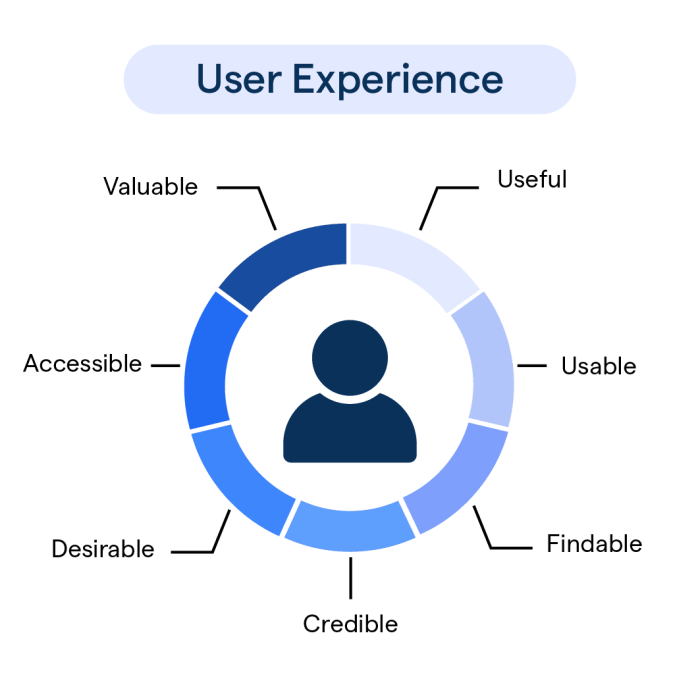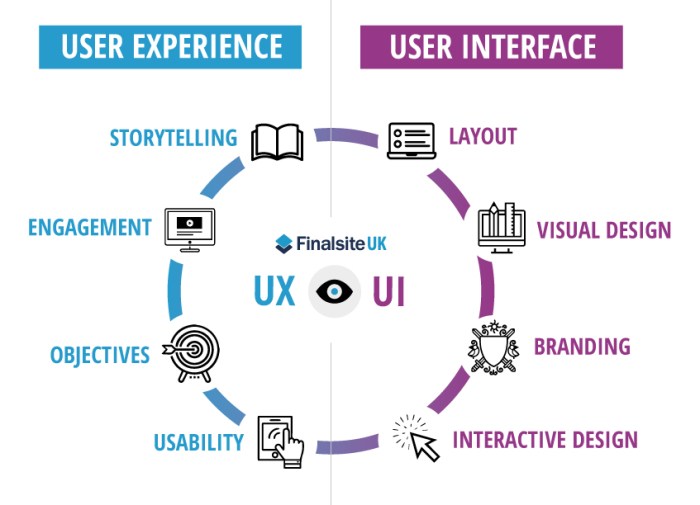Crafting Exceptional UX: A Comprehensive Guide
As UX takes center stage, this opening passage beckons readers into a world crafted with good knowledge, ensuring a reading experience that is both absorbing and distinctly original. With the increasing focus on user experience, understanding UX design principles and research methodologies becomes paramount for businesses striving to enhance customer satisfaction and drive success.
This guide delves into the key elements of UX, the significance of user research, information architecture, design principles, and usability testing, offering a comprehensive overview for both beginners and seasoned professionals in the field.
Introduction to UX
User Experience (UX) refers to the overall experience a person has when interacting with a product or service. It encompasses aspects such as usability, accessibility, and desirability, aiming to create a seamless and enjoyable experience for users. In product design, UX plays a crucial role in determining how users perceive and interact with a product, ultimately influencing their satisfaction and loyalty.
Significance of UX in Product Design
Effective UX design can have a significant impact on both user satisfaction and business success. By prioritizing user needs and preferences, companies can create products that are intuitive, easy to use, and visually appealing. This, in turn, leads to higher customer satisfaction, increased user engagement, and ultimately, improved business outcomes.
Key Elements of Successful UX Design
- Usability: Ensuring the product is easy to use and navigate, with intuitive interfaces and clear instructions.
- Accessibility: Making the product accessible to users of all abilities, including those with disabilities.
- Desirability: Creating a visually appealing and engaging design that attracts and retains users.
- Performance: Ensuring the product is fast, responsive, and reliable, providing a seamless user experience.
- Consistency: Maintaining a consistent design language and user interface throughout the product to avoid confusion.
UX Research

User research plays a crucial role in UX design as it helps designers understand the needs, behaviors, and preferences of the target users. By conducting research, designers can create products that are tailored to meet the users' requirements, leading to a better user experience.
Methods for Conducting UX Research
- User Interviews: One-on-one interviews with users to gather insights into their goals, challenges, and expectations.
- Surveys: Online questionnaires distributed to a larger group of users to collect quantitative data on user preferences and feedback.
- Usability Testing: Observing users as they interact with a prototype or product to identify usability issues and areas for improvement.
Personas and User Journey Mapping
Personas are fictional representations of the target users, based on research data, to help designers empathize with and design for specific user groups. User journey mapping visualizes the user's interactions with a product or service, highlighting pain points and opportunities for enhancing the user experience.
Information Architecture
Information architecture plays a crucial role in UX by organizing and structuring information in a way that is intuitive and user-friendly. It involves designing the navigation, labeling, and categorization of content to ensure that users can easily find what they are looking for on a website or app.
User-Friendly Information Architecture
Creating a user-friendly information architecture involves several key steps to enhance the overall user experience:
- Conduct User Research: Understand the needs and behaviors of your target users to design a structure that aligns with their expectations.
- Organize Content: Group related information together and create a logical hierarchy to help users navigate efficiently.
- Clear Navigation: Implement intuitive navigation menus, breadcrumbs, and search functionalities to guide users through the content easily.
- Consistent Labels: Use clear and consistent terminology for labeling categories and sections to avoid confusion.
Importance of Clear Navigation and Content Organization
Clear navigation and content organization are essential for enhancing UX in the following ways:
- Improves Findability: Users can quickly locate the information they need without getting lost in a maze of content.
- Enhances User Engagement: A well-organized structure keeps users engaged and encourages them to explore more content.
- Reduces Cognitive Load: By providing a clear structure, users can focus on the content without being overwhelmed by complex navigation.
- Boosts Conversions: Easy access to key information can lead to higher conversion rates as users can complete tasks efficiently.
UX Design Principles
In UX design, there are several key principles that designers follow to create user-friendly and effective interfaces. These principles focus on ensuring that the design is intuitive, easy to use, and provides a seamless experience for the user.
Usability
Usability is a fundamental principle in UX design that focuses on making the interface easy to navigate and understand. Designers aim to create interfaces that are intuitive and require minimal effort from the user to accomplish tasks. For example, placing commonly used features in easily accessible locations, using clear and concise language, and providing helpful error messages are all ways to enhance usability in UX design.
Learnability
Learnability refers to how easy it is for users to understand and learn how to use a new interface. Designers strive to create interfaces that are easy to learn, even for first-time users. By incorporating familiar design patterns, providing clear instructions or tutorials, and offering feedback on user actions, designers can improve the learnability of a product.
Efficiency
Efficiency in UX design focuses on helping users accomplish tasks quickly and with minimal effort. This principle involves streamlining workflows, reducing the number of steps required to complete a task, and optimizing the interface for speed. For example, providing keyboard shortcuts, autocomplete suggestions, and predictive search functionalities can all contribute to enhancing efficiency in UX design.
Impact of Responsive Design
Responsive design plays a crucial role in enhancing user experience by ensuring that interfaces adapt seamlessly to different devices and screen sizes. By implementing responsive design principles, designers can create interfaces that are accessible and functional across a variety of devices, from desktop computers to smartphones and tablets.
This approach helps improve user engagement, reduces bounce rates, and ultimately contributes to a positive user experience.
Usability Testing
Usability testing is a crucial step in the UX design process as it helps identify issues and gather feedback from users to improve the overall user experience of a product or website. By observing how real users interact with a system, designers can uncover usability problems, understand user behaviors, and make data-driven decisions to enhance the usability of the interface.
Different Usability Testing Methods
- A/B Testing: Involves comparing two versions of a design to see which one performs better in terms of user engagement and conversion rates.
- Eye Tracking: Tracks where users look on a screen to understand visual attention and optimize the layout of elements.
- Think-Aloud Protocol: Users verbalize their thoughts while interacting with a product, providing insights into their decision-making process.
- Remote Usability Testing: Conducted online, allowing designers to gather feedback from a larger and more diverse group of users.
Best Practices for Conducting Effective Usability Tests
- Define clear objectives and goals for the test to focus on specific usability issues.
- Recruit diverse participants who represent the target user demographic to ensure comprehensive feedback.
- Create realistic scenarios for users to complete tasks that mimic real-world usage.
- Encourage participants to think aloud and provide honest feedback during the testing session.
- Analyze and prioritize the findings to address critical usability issues and make informed design decisions.
Ultimate Conclusion

In conclusion, mastering the art of UX design is essential for creating products and services that resonate with users and drive business growth. By incorporating best practices in research, design principles, and usability testing, businesses can elevate their offerings to meet the evolving needs of their target audience.
As the digital landscape continues to evolve, a focus on exceptional UX remains a key differentiator in a competitive market.
Top FAQs
What is UX design?
UX design focuses on creating meaningful and satisfying experiences for users interacting with products or services.
How does UX impact business success?
Good UX can lead to increased customer satisfaction, loyalty, and ultimately business growth.
What is information architecture in UX?
Information architecture involves organizing and structuring content in a clear and user-friendly way to enhance the overall user experience.
Why is usability testing important in UX design?
Usability testing helps identify usability issues, allowing for improvements to enhance the overall user experience.




